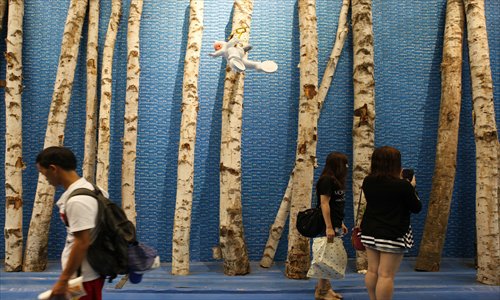Strait to the point

It's a scene of pure dystopia, with rusty pipes and broken machines reassembled in new facilities. If observed closely, you'll identify the logos of famous oil companies. Be careful when stepping forward though, as under your feet are blue, uneven steel titles spread out. This isn't the set of a blockbuster sci-fi movie, rather it's the site of two exhibitions, namely Wang Mai's "Dire Straits" and "Curated by Wang Xinwei: Specificity," both which were unveiled at the Ullens Center for Contemporary Art (UCCA) on July 21.
The UCCA prides itself on taking a keen interest in modern Chinese art, with this year no exception. Wang Mai's installation Ullens Straits spans a 9-meter-high, 30-meter-wide space within UCCA's Nave, and aims to present a space brimming with conflict. This, together with the artist's other paintings, including Memories of a Loser and installation Climate Boxes, conveys Wang's thoughts on modernity.
According to Wang, Ullens Straits was specifically designed for the UCCA. "The Nave at the UCCA is a long, narrow, tall building, just like a strait," said Wang. "A strait is usually a symbol of conflict on the international stage of politics, which resonates with the UCCA's position as a hub of conflicting Western and Chinese modern art."
The decor of Wang's exhibitions reflects his deep interest in geopolitics. Blue walls of the space are decorated with empty cartons of Zhongnanhai cigarettes - a renowned Beijing brand that shares the name of the central headquarters for the Communist Party of China.
Logos of oil giants on rusty machines symbolize different corporations' legacies of depleting the world of its natural resources. Other notable icons include logs Wang erected alongside the walls that were inspired by the forest life of nomadic tribes in his hometown of Yichun in Northeast China's Heilongjiang Province.
Wang, who was born in 1972, is widely regarded as a multimedia pioneer of his generation. Throughout the 1990s he dabbled in different art forms including painting, installation art and poetry, but all his works had a global consciousness that focused on real-life events.
On the other side of the Nave is the exhibition "Curated by Wang Xinwei: Specificity," which features paintings by seven artists. Most are realist, and depict artists' perceptions on life. According to Wang Xinwei, the exhibition's namesake curator, it contains four distinct but interrelated notions of aesthetics, namely the elimination of ranking, irreplaceability, ineffable condition and a sense of truth.
"The elimination of ranking refers to paying attention to neglected items, overlooked details and ignored feelings. Irreplaceability refers to specifying an object or person to make it distinct from itself," said Wang Xingwei. "An ineffable condition refers to a hypnotizing sense of unfamiliarity, while a sense of truth symbolizes the artists' own understanding of reality."
"I see things others ignore or disregard as trivial," said Zhang Shujian, another artist whose works are displayed at the exhibition.
When: Until August 30
Where: UCCA, 798 Art Zone, 2-4 Jiuxianqiao Road, Chaoyang district
Admission: 10 yuan (free Thursdays)
Contact: 5780-0200